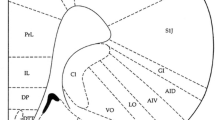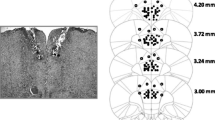Abstract
The effects of cholecystokinin (CCK) receptor ligands were studied in the rat safety signal withdrawal conflict procedure, an operant paradigm sensitive to both anxiolytic and anxiogenic compounds. In this procedure, behavioural suppression of lever pressing for food was induced by the withdrawal of a conditioned signal for safety without the usual presentation of a conditioned signal for danger. The compounds tested were selective CCK-B antagonists [CI-988 (0.01–1 mg/kg SC), L-365,260 (0.004–2 mg/kg IP) and LY 262,691 (0.001–1 mg/kg SC)], CCK-B agonists [CCK-4 (0.01–1 mg/kg SC) and BC 264 (0.004–1 mg/kg IP)] and CCK-A antagonists [devazepide (0.001–1 mg/kg SC) and lorglumide (0.01–1 mg/kg SC)]. None of these drugs induced the expected behavioural effects, i.e. an anxiolytic-like release of the behavioural suppression with CCK-B and, possibly, CCK-A antagonists and/or a further reduction of lever pressing with CCK-B agonists, indicative of an anxiogenic-like potential. In contrast, the established anxiolytic lorazepam (0.06–0.25 mg/kg IP), as well as diazepam (2 mg/kg IP) and buspirone (0.25 mg/kg SC) used as positive control drugs, released the suppression of pressing for food during the period associated with the safety signal withdrawal, whereas picrotoxin (1 mg/kg IP), used as an anxiogenic control, further reduced responding during this conflict period. The present results contrast with a series of published data suggesting the involvement of CCK processes in anxiety-related behaviour in rodent models such as the elevated plus-maze or the light:dark two compartment test, and in panic disorders in humans. They indicate that the behavioural effects of one category of drugs might vary considerably, depending on the experimental situation. Furthermore, they allow the conclusion that anticipatory anxiety generated by withdrawal of conditioned signals for safety does not involve CCK-related processes.
Similar content being viewed by others
References
Abelson JL, Nesse RM (1994) Pentagastrin infusions in patients with panic disorder. I. Symptoms and cardiovascular responses. Biol Psychiatry 36:73–83
Bickerdike MJ, Marsden CA, Dourish CT, Fletcher A (1994) The influence of 5-hydroxytryptamine re-uptake blockade on CCK receptor antagonist effects in the rat elevated zero-maze. Eur J Pharmacol 271:403–411
Bradwejn J, Koszycki D (1994) Imipramine antagonism of the panicogenic effects of cholecystokinin tetrapeptide in panic disorder patients. Am J Psychiatry 151:261–263
Bradwejn J, Koszycki D, Shriqui C (1991) Enhanced sensitivity to cholecystokinin tetrapeptide in panic disorder. Clinical and behavioral findings. Arch Gen Psychiatry 48:603–610
Bradwejn J, Koszycki D, Annable L, Couëtoux du Tertre A, Reines S, Karkanias C (1992) A dose-ranging study of the behavioral and cardiovascular effects of CCK-tetrapeptide in panic disorder. Biol Psychiatry 32:903–912
Bradwejn J, Koszycki D, Couëtoux du Tertre A, van Megen H, Den Boer J, Westenberg H, Annable L (1994a) The panicogenic effects of cholecystokinin-tetrapeptide are antagonized by L-365,260, a central cholecystokinin receptor antagonist, in patients with panic disorder. Arch Gen Psychiatry 51:486–493
Bradwejn J, Paradis M, Koszycki D, Reece P, Sedman A (1994b) The effects of CI-988 on panic in healthy volunteers. Neuropsychopharmacology 10[3S/Part 2]: 12S (Abstr.)
Charpentier B, Durieux C, Pélaprat D, Dor A, Reibaud M, Blanchard JC, Roques BP (1988) Enzyme-resistant CCK analogs with high affinities for central receptors. Peptides 9:835–841
Charrier D, Dangoumau L, Hamon M, Puech AJ, Thiébot MH (1994) Effects of 5-HT1A receptor ligands on a safety signal withdrawal procedure of conflict in the rat. Pharmacol Biochem Behav 48:281–289
Chopin P, Briley M (1993) The benzodiazepine antagonist flumazenil blocks the effects of CCK receptor agonists and antagonists in the elevated plus-maze. Psychopharmacology 110:409–414
Costall B, Domeney AM, Hughes J, Kelly ME, Naylor RJ, Woodruff GN (1991) Anxiolytic effects of CCK-B antagonists. Neuropeptides 19:65–73
Crawley JN, Corwin RL (1994) Biological actions of cholecystokinin. Peptides 15:731–755
Cutler NR, Sramek JJ, Kramer MS, Reines SA (1994) Pilot study of a CCKB antagonist in panic disorder. Biol Psychiatry 35:680 (Abst.)
Daugé V, Steimes P, Derrien M, Beau N, Roques BP, Féger J (1989) CCK8 effects on motivational and emotional states of rats involve CCKA receptors of the postero-median part of the nucleus accumbens. Pharmacol Biochem Behav 34:157–163
Daugé V, Derrien M, Durieux C, Noble F, Corringer PJ, Roques BP (1992) Etude des effets induits par les agonistes sélectifs CCK-B de la cholecystokinine dans la nociception et le comportement des rongeurs. Thérapie 47:531–539
Dawson GR, Rupniak NMJ, Iversen SD, Tricklebank MD (1994) Lack of effect of CCKB receptor antagonists in animal screens for anxiolytic drugs. J Psychopharmacol Abstract book BAP/ISPB (July):A-47
De Montigny C (1989) Cholecystokinin tetrapeptide induces panic-like attacks in healthy volunteers. Arch Gen Psychiatry 46:511–517
Den Boer JA, van Megen HJGM, Westenberg HGM (1994) Significance of CCK-B receptors in the neurobiology of panic disorder. Eur Neuropharmacol 4:273–275 (Abst.)
Derrien M, Durieux C, Roques BP (1994a) Antidepressant-like effects of CCKB antagonits in mice:antagonism by naltrindole. Br J Pharmacol 111:956–960
Derrien M, McCort-Tranchepain I, Ducos B, Roques BP, Durieux C (1994b) Heterogeneity of CCK-B receptors involved in animal models of anxiety. Pharmacol Biochem Behav 49:133–141
Dooley DJ, Klamt I (1993) Differential profile of the CCKB receptor antagonist CI-988 and diazepam in the four-plate test. Psychopharmacology 112:452–454
Dourish CT, Bickerdike MJ, Stanhope KJ, Fletcher A, Marsden CA (1994) Profile of CCKA and CCKB receptor antagonists in the CER and elevated zero maze models of anxiety in the rat:modulation by 5-HT reuptake blockade. Behav Pharmacol 5 [Suppl. 1]:29–30
Fink H, Rex A, Marsden CA (1994) Behavioural and neurochemical effects of CCK-fragments in animal models of anxiety. Behav Pharmacol 5 [Supp. 1]:30
Geller I, Seifter J (1960) The effects of meprobamate, barbiturate,d-amphetamine and promazine on experimentally-induced conflict in the rat. Psychopharmacologia 1:482–492
Harro J, Vasar E (1991a) Cholecystokinin-induced anxiety:How is it reflected in studies on exploratory behaviour? Neurosci Biobehav Rev 15:473–477
Harro J, Vasar E (1991b) Evidence that CCK-B receptor mediate the regulation of exploratory behavior in the rat. Eur J Pharmacol 193:473–477
Harro J, Vasar E, Bradwejn J (1993) CCK in animal and human research on anxiety. Trends Pharmacol Sci 14:244–249
Hendrie CA, Neill JC (1992) Ethological analysis of the role of CCK in anxiety. In: Dourish CT, Cooper SJ, Iversen SD, Iversen LL (eds) Multiple cholecystokinin receptors in the CNS. Oxford University Press, Oxford, pp 132–142
Hendrie CA, Neill JC, Shepherd JK, Dourish CT (1993) The effects of CCKA and CCKB antagonists on activity in the black/white exploration model of anxiety in mice. Physiol Behav 54:689–693
Hughes J, Boden P, Costall B, Domeney A, Kelly E, Horwell DC, Hunter JC, Pinnock RD, Woodruff GN (1990) Development of a class of selective cholecystokinin type B receptor antagonists having potent anxiolytic activity. Proc Natl Acad Sci USA 87:6728–6732
Palmour R, Ervin R, Bradwejn J, Howbert J (1991) The anxiogenic and cardiovascular effects of CCK-4 are blocked by the CCK-B antagonist LY 262,691. Soc Neurosci 17:1602
Palmour RM, Bradwejn J, Ervin FR (1992) The anxiogenic effects of CCK-4 in monkeys are reduced by CCK-B antagonists, benzodiazepines or adenosine A2 agonists. Eur Neuropharmacol 2:193–195
Powell KR, Barrett JE (1991) Evaluation of the effects of PD 134308 (CI-988), a CCK-B antagonist, on the punished responding of squirrel monkeys. Neuropeptides 19:75–78
Rataud S, Darche F, Piot O, Stutzmann JM, Böhme GA, Blanchard JC (1991) “Anxiolytic” effect of CCK-antagonists on plus-maze behavior in mice. Brain Res 548:315–317
Ravard S, Dourish CT, Iversen SD (1990) Anxiolytic-like effects of the CCK antagonists L-365,260 and devazepide in the elevated plus-maze paradigm. J Psychopharmacol 4:281
Rex A, Fink H, Marsden CA (1993) The effects of CCK-4 and L-365.260 on cortical extracellular 5-HT release on exposure on the elvated plus maze. In: Hamon M, Ollat H, Thiébot MH (eds) Anxiety:neurobiology, clinic and therapeutic perspectives. vol. 232. John Libbey Eurotext/Editions INSERM, pp 207–208
Rex A, Barth T, Voigt JP, Domeney AM, Fink H (1994) Effects of cholecystokinin tetrapeptide and sulfated cholecystokinin octapeptide in rat models of anxiety. Neurosci Lett 172:139–142
Singh L, Field MJ, Hughes J, Menzies R, Oles RJ, Vass CA, Woodruff GN (1991a) The behavioural properties of CI-988, a selective cholecystokininB receptor antagonist. Br J Pharmacol 104:239–245
Singh L, Lewis AS, Field MJ, Hughes J, Woodruff GN (1991b) Evidence for an involvement of the brain cholecystokinin B receptor in anxiety. Proc Natl Acad Sci USA 88:1130–1133
Thiébot MH, Hamon M, Soubrié P (1982) Attenuation of induced-anxiety in rats by chlordiazepoxide:role of raphe dorsalis benzodiazepine binding sites and serotoninergic neurons. Neuroscience 7:287–294
Thiébot MH, Dangoumau L, Richard G, Puech AJ (1991) Safety signal withdrawal: a behavioural paradigm sensitive to both “anxiolytic” and “anxiogenic” drugs under identical experimental conditions. Psychopharmacology 103:415–424
Van Megen HJGM, Westenberg HGM, Den Boer JA, Haigh JRM, Traub M (1994) Pentagastrin induced panic attacks:enhanced sensitivity in panic disorder patients. Psychopharmacology 114:449–455
Vasar E, Harro J, Pôld A, Lang A (1992) CCK receptors and anxiety in rats. In: Dourish CT, Cooper SJ, Iversen SD, Iversen LL (eds) Multiple cholecystokinin receptors in the CNS. Oxford University Press, Oxford, pp 143–148
Vasar E, Lang A, Harro J, Bourin M, Bradwejn J (1994) Evidence for potentiation by CCK antagonists of the effect of cholecystokinin octapeptide in the elvated plus-maze. Neuropharmacology 33:729–735
Author information
Authors and Affiliations
Rights and permissions
About this article
Cite this article
Charrier, D., Dangoumau, L., Puech, A.J. et al. Failure of CCK receptor ligands to modify anxiety-related behavioural suppression in an operant conflict paradigm in rats. Psychopharmacology 121, 127–134 (1995). https://doi.org/10.1007/BF02245599
Received:
Revised:
Issue Date:
DOI: https://doi.org/10.1007/BF02245599




